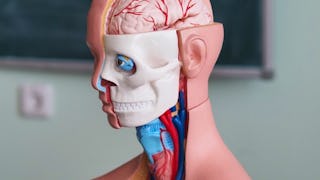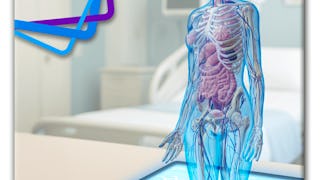This course explores the urinary, nervous, endocrine, reproductive, and integumentary systems, focusing on how they integrate within the body and regulate homeostasis.


您将学到什么
Learners will explore the structure and functions of the urinary, nervous, endocrine, reproductive, and integumentary systems.
Learners will understand how these systems regulate essential physiological processes and maintain homeostasis.
您将获得的技能
要了解的详细信息

添加到您的领英档案
29 项作业
了解顶级公司的员工如何掌握热门技能

积累特定领域的专业知识
- 向行业专家学习新概念
- 获得对主题或工具的基础理解
- 通过实践项目培养工作相关技能
- 获得可共享的职业证书

该课程共有6个模块
In this lesson, learners will explore the structure and functions of the urinary system, including the kidneys, ureters, bladder, and urethra. The role of the kidneys in blood filtration, waste removal, and maintaining homeostasis will be highlighted, with an emphasis on processes such as the function of nephrons, pH regulation, and blood pressure control. Additionally, common urinary system disorders, such as kidney stones, urinary tract infections, and chronic kidney disease, will be discussed to provide context for understanding how dysfunctions in this system can affect overall health.
涵盖的内容
5个视频5个作业
In this lesson, learners will explore the structure and functions of the male and female reproductive systems, highlighting the roles of key organs such as the testes, ovaries, and uterus. The importance of reproductive hormones, such as testosterone, estrogen, and progesterone, in regulating reproductive processes and maintaining homeostasis will be emphasized, alongside the hormonal feedback mechanisms of the hypothalamic-pituitary-gonadal (HPG) axis. The process of fertilization will be described, demonstrating the intricate coordination required for the union of sperm and egg and subsequent development of a zygote. Finally, the lesson will address common reproductive health disorders, such as endometriosis, polycystic ovary syndrome (PCOS), and infertility, and their impact on overall health and well-being.
涵盖的内容
6个视频5个作业
In this lesson, learners will explore the structure and functions of the lymphatic system, including its role in maintaining fluid balance and supporting immune defense. The anatomy of the lymphatic system will be highlighted, including lymphatic vessels, lymph nodes, and major ducts such as the thoracic duct. The primary and secondary lymphoid organs will be explained, emphasizing their roles in lymphocyte production and immune responses. Additionally, the importance of lymph nodes and the spleen in filtering lymph and blood, and their critical roles in protecting the body from infections, will be discussed.
涵盖的内容
4个视频5个作业
This lesson provides an overview of the endocrine system, emphasizing its role in regulating body processes through hormones. Learners will explore the major endocrine glands, such as the hypothalamus, pituitary, thyroid, adrenal glands, pancreas, and gonads, and their functions in maintaining homeostasis. The lesson also highlights the integration of the endocrine system with other systems, including its critical role in stress response, metabolism, and reproduction. Through clear examples and practical applications, this lesson demonstrates the importance of the endocrine system in maintaining balance within the body.
涵盖的内容
4个视频5个作业
This lesson will provide an overview of the integumentary system, including the structure and functions of the epidermis, dermis, and subcutaneous layer. Key appendages such as hair follicles, sweat glands, and nails will be discussed, emphasizing their roles in protection, temperature regulation, and sensory perception. The lesson will also cover dermatomes and their significance in sensory mapping and referred pain, illustrating the interconnectedness of the integumentary and nervous systems.
涵盖的内容
4个视频4个作业
In this lesson, learners will explore the components and functions of the nervous system, focusing on its divisions: the central nervous system (CNS), peripheral nervous system (PNS), and autonomic nervous system (ANS). The roles of the brain and spinal cord in processing sensory input and controlling motor output will be highlighted, alongside the distinctions between gray and white matter. The lesson will also cover the integration of sensory and motor functions through reflex arcs, emphasizing the nervous system's role in maintaining rapid communication and coordination within the body.
涵盖的内容
4个视频5个作业
获得职业证书
将此证书添加到您的 LinkedIn 个人资料、简历或履历中。在社交媒体和绩效考核中分享。
位教师



提供方
从 Basic Science 浏览更多内容
 状态:免费试用
状态:免费试用Rice University
 状态:免费试用
状态:免费试用Rice University
 状态:免费试用
状态:免费试用 状态:免费试用
状态:免费试用
人们为什么选择 Coursera 来帮助自己实现职业发展




常见问题
To access the course materials, assignments and to earn a Certificate, you will need to purchase the Certificate experience when you enroll in a course. You can try a Free Trial instead, or apply for Financial Aid. The course may offer 'Full Course, No Certificate' instead. This option lets you see all course materials, submit required assessments, and get a final grade. This also means that you will not be able to purchase a Certificate experience.
When you enroll in the course, you get access to all of the courses in the Specialization, and you earn a certificate when you complete the work. Your electronic Certificate will be added to your Accomplishments page - from there, you can print your Certificate or add it to your LinkedIn profile.
Yes. In select learning programs, you can apply for financial aid or a scholarship if you can’t afford the enrollment fee. If fin aid or scholarship is available for your learning program selection, you’ll find a link to apply on the description page.
更多问题
提供助学金,

